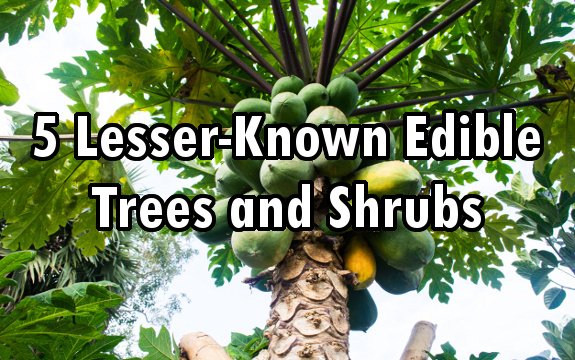5 Lesser-Known Edible Trees and Shrubs

 A garden is usually the first thing that comes to people’s minds when they think about eating out of their yard. If we’re talking about trees and shrubs, they may think of apple, pear, peach, or cherry trees. But there are many other edible plants that don’t get as much attention. These trees and shrubs could offer variety to your homegrown food supply and may grow even better than the more common ones depending on your climate.
A garden is usually the first thing that comes to people’s minds when they think about eating out of their yard. If we’re talking about trees and shrubs, they may think of apple, pear, peach, or cherry trees. But there are many other edible plants that don’t get as much attention. These trees and shrubs could offer variety to your homegrown food supply and may grow even better than the more common ones depending on your climate.
There are numerous fruit-producing trees and shrubs you can plant which don’t receive mainstream attention. The first key to determining what will grow well where you live is knowing your plant hardiness zone. This zone, developed by the USDA for the states in the US, takes climate into consideration when determining what will grow best. They are based on temperatures at the coldest time of year, so you aren’t trying to grow things that simply won’t survive. If you’re in the US, you can find your zone on the map shown here.
Knowing your local climate makes choosing appropriate edibles that much easier. Colder climates have lower zone numbers while warmer climates are higher. The southernmost tip of Florida, for instance, is in zone 11a, where things like tropical fruits and avocados can easily be grown.
Read: 5 Easiest Vegetables to Grow Without Gardening Skills
But most of us in the US aren’t so lucky. For the rest of us, here are some edible trees and shrubs that pack beauty and deliciousness, but rarely get the attention of their better known counterparts.
- 1. Highbush Cranberry – Able to reach 15 feet tall and best suited for zones 2 to 7, the Highbush Cranberry offers bright red fruits and flowers – both being very pretty. Many people are happy to use these for ornamentals, but the early-harvested berries have a great sweet taste.
- 2. Mulberry – Mulberry bushes are attractive, but messy. They drop their fruit and leave bright red and purple stains everywhere. The trick is to lay down a canvas or tarp and shake the tree to get all of the loose fruit harvested before it falls. Mulberries are good for desserts, jellies, and eating fresh, and they do best in zones 5 through 8.
- 3. Pawpaw – The pawpaw tree has a long history in the southern states and does well in zones 5 to 8. It grows small maroon flowers and long yellow fruits. If you plant this one, you’ll need two unrelated trees for successful pollination. The Native Americans used it as a common food source.
- 4. Persimmon – Another tree more common to the south, Persimmon can reach 30 feet tall. These trees do well in zones 4 through 9 and produce distinctly flavored golden-orange fruit.
- 5. Hardy Kiwifruit – Related to standard kiwifruit but better suited to colder temperatures, the hardy kiwifruit (Actinidia aruguta) does well up to zone 4. It’s a vining plant with smaller fruits. It is also very vigorous and will take over surrounding plants if not pruned and kept under control. Check out kiwi fruit benefits here.
For more little-known fruit trees and shrubs, check back at NaturalSociety in the future. If you’d rather eat what is already growing in your yard, take a look at the benefits of eating dandelions for really organic “weed” control.
